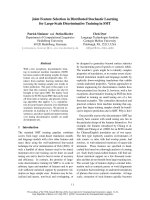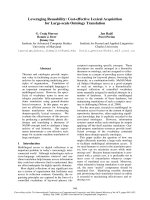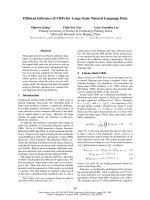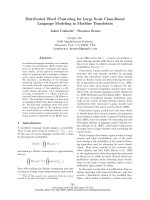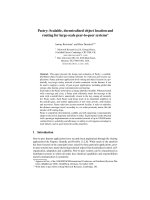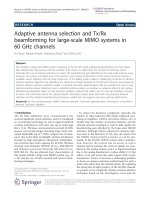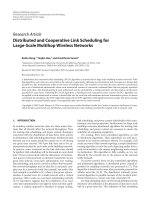Inexact interior point methods for large scale linear and convex quadratic semidefinite programming
Bạn đang xem bản rút gọn của tài liệu. Xem và tải ngay bản đầy đủ của tài liệu tại đây (951.76 KB, 146 trang )
INEXACT INTERIOR-POINT METHODS
FOR LARGE SCALE LINEAR AND CONVEX
QUADRATIC SEMIDEFINITE
PROGRAMMING
LI LU
(B.Sc., SJTU, China)
A THESIS SUBMITTED
FOR THE DEGREE OF DOCTOR OF PHILOSOPHY
DEPARTMENT OF MATHEMATICS
NATIONAL UNIVERSITY OF SINGAPORE
2010
To my parents
Acknowledgements
I would like to express my heartfelt gratitude to my advisor Professor Toh Kim-
Chuan, for his invaluable guidance and expertise in optimization, his utmost sup-
port and encouragement throughout the past five years. Without him, this thesis
would never have been possible. The way of conducting scientific research, the
opening posture towards new ideas and the attitude on teaching that I learned
from him would be a lifelong treasure.
I would like to express my sincere thanks to Professor Zhao Gongyun for his in-
struction on game theory and numerical optimization, which are the first and the
last modules I took during my study in NUS. I sincerely thank him for sharing
with me his wisdom and experience in the field of numerical computation and
optimization theory.
I am also indebted to Professor Sun Defeng for his continuous effort on conduct-
ing weekly optimization seminars in Department of Mathematics, NUS. His broad
knowledge and enthusiasm on optimization have helped me tremendously in ex-
ploring various topics.
I am also thankful to Dr. Liu Yongjin, Dr. Yun Sangwoon and Dr. Zhao Xinyuan
v
vi Acknowledgements
for their helpful and constructive discussions in many topics related to my thesis.
This acknowledgement will remain incomplete without expressing my gratitude to
my fellow colleagues and friends at NUS, where many happy memories I will carry
from.
My thanks also goes out to National University of Singapore and Department of
Mathematics for providing me excellent working conditions and scholarships to
complete my study.
Contents
Acknowledgements v
Summary xi
List of Tables xiii
Notation xvi
1 Introduction 1
1.1 The bottleneck of interior-point methods . . . . . . . . . . . . . . . 2
1.2 Organization of the thesis . . . . . . . . . . . . . . . . . . . . . . . 5
1.3 Convex quadratic SDP . . . . . . . . . . . . . . . . . . . . . . . . . 7
1.4 Sparse covariance selection . . . . . . . . . . . . . . . . . . . . . . . 10
1.5 Dual-scaling interior-point methods . . . . . . . . . . . . . . . . . . 16
2 Symmetric cones and Euclidean Jordan Algebras 19
vii
viii Contents
3 Polynomial-time inexact interior-point methods for convex quadrat-
ic programming over symmetric cones 29
3.1 Convex quadratic symmetric cone programming . . . . . . . . . . . 30
3.2 An infeasible central path and its neighborhood . . . . . . . . . . . 33
3.3 An inexact infeasible interior-point algorithm . . . . . . . . . . . . . 38
3.4 Proof of Lemma 3.7 . . . . . . . . . . . . . . . . . . . . . . . . . . . 44
4 Inexact primal-dual path-following methods for l
1
-regularized log-
determinant semidefinite programming problem 57
4.1 A customized inexact primal-dual interior-point method . . . . . . . 58
4.2 Preconditioners . . . . . . . . . . . . . . . . . . . . . . . . . . . . . 64
4.3 Computation of search direction for the special case (1.8) . . . . . . 66
4.3.1 Computing (∆x, ∆y) first . . . . . . . . . . . . . . . . . . . 67
4.3.2 Computing (∆y, ∆u) first . . . . . . . . . . . . . . . . . . . 69
4.4 Numerical Experiment . . . . . . . . . . . . . . . . . . . . . . . . . 71
4.4.1 Synthetic Examples . . . . . . . . . . . . . . . . . . . . . . . 72
4.4.2 Real world examples . . . . . . . . . . . . . . . . . . . . . . 78
5 An inexact dual-scaling interior-point method for linear program-
ming problems over symmetric cones 83
5.1 An inexact dual-scaling interior point algorithm . . . . . . . . . . . 84
5.1.1 Inexact search directions . . . . . . . . . . . . . . . . . . . . 87
5.2 Verification of the admissible condition (5.13b) . . . . . . . . . . . . 95
5.3 A practical inexact-direction dual-scaling algorithm . . . . . . . . . 98
5.4 Numerical experiments . . . . . . . . . . . . . . . . . . . . . . . . . 103
6 Conclusions and future work 111
Contents ix
Bibliography 113
Summary
Interior-point methods have been intensively studied during the last few decades.
In theory, interior-point methods can solve a wide range of convex programming
problems to high accuracy in polynomial time. In practice, the difficulty faced by
interior-point methods is to compute the search direction from a linear system in
each iteration. Classical interior-point methods use a direct solver such as Cholesky
factorization to store and solve the linear system. Thus only small to medium scale
problems are solvable due to limited computer memory and processing speed. A
well-known alternative approach is the inexact interior-point method. As the name
suggests, this method applies iterative solvers to the linear system to avoid storing
and manipulating the large coefficient matrix explicitly. Its consequence is that
the search direction in each iteration becomes inexact because the linear system is
only solved approximately.
To ensure that the inexact search directions do not jeopardize the polynomial
convergence of the interior-point algorithm, the effect of the inexactness needs
to be carefully reviewed and controlled. In this thesis, we developed an inexact
primal-dual path-following interior-point method for convex quadratic symmetric
xi
xii Summary
cone programming problems and an inexact dual-scaling interior-point method
for linear symmetric cone programming problems. Admissible conditions on the
inexactness are thoroughly discussed and polynomial convergence is established.
The motivation for studying inexact interior-point methods is to obtain high perfor-
mance in numerical experiments. However, a naive implementation of the iterative
solvers may not lead to better performance. The real bottleneck of inexact interior-
point methods is to construct efficient preconditioners for the iterative solvers since
the linear system in each iteration is generally ill-conditioned. The construction of
preconditioners is heavily dependent on the particular structure of each problem
class. As an example, we proposed a customized inexact primal-dual interior-point
algorithm with specialized preconditioners for solving log-determinant semidefinite
programming problems with l
1
-regularization. Extensive numerical experiments on
covariance selection problems demonstrate that our customized inexact interior-
point methods are efficient and robust in solving covariance selection problems,
outperforming many existing algorithms.
List of Tables
4.1 Comparison of the IIPM and ANS methods in solving the problems
(1.6) and (1.7) with the data matrix
Σ generated from Example
1. The regularization parameter ρ is set to ρ = 5/p for all the
problems. The numbers in each parenthesis are the average number
of MINRES steps taken in each iteration, Loss
Q
, Loss
E
, Specificity
and Sensitivity, respectively. . . . . . . . . . . . . . . . . . . . . . 73
4.2 Comparison of the IIPM and ANS methods in solving the problem
(1.6) with the data matrix
Σ generated from Example 2. The reg-
ularization parameter ρ is set to ρ = 0.1 for all the problems. The
numbers in each parenthesis are the average number of MINRES
steps taken in each iteration, Loss
Q
, Loss
E
, Specificity and Sensitiv-
ity, respectively. . . . . . . . . . . . . . . . . . . . . . . . . . . . . 76
xiii
xiv List of Tables
4.2 Comparison of the IIPM and ANS methods in solving the problem
(1.6) with the data matrix
Σ generated from Example 2. The reg-
ularization parameter ρ is set to ρ = 0.1 for all the problems. The
numbers in each parenthesis are the average number of MINRES
steps taken in each iteration, Loss
Q
, Loss
E
, Specificity and Sensitiv-
ity, respectively. . . . . . . . . . . . . . . . . . . . . . . . . . . . . 77
4.3 Comparison of the IIPM and ANS methods in solving the problem
(1.7) with the data matrix
Σ generated from Example 2. The reg-
ularization parameter ρ is set to ρ = 0.1 for all the problems. The
numbers in each parenthesis are the average number of MINRES
steps taken in each iteration, Loss
Q
, Loss
E
, Specificity and Sensitiv-
ity, respectively. . . . . . . . . . . . . . . . . . . . . . . . . . . . . 78
4.4 Comparison of the IIPM and ANS methods on the problem (1.6)
using gene data sets. The number in parenthesis is the average
number of MINRES steps taken in each iteration. In the table, r is
the rank of
Σ. . . . . . . . . . . . . . . . . . . . . . . . . . . . . . 81
5.1 Numerical results for the practical DIPM algorithm on computing
maximum stable set problems with the search directions in (5.35)
computed via the PCR method . . . . . . . . . . . . . . . . . . . . 105
5.1 Numerical results for the practical DIPM algorithm on computing
maximum stable set problems with the search directions in (5.35)
computed via the PCR method . . . . . . . . . . . . . . . . . . . . 106
5.1 Numerical results for the practical DIPM algorithm on computing
maximum stable set problems with the search directions in (5.35)
computed via the PCR method . . . . . . . . . . . . . . . . . . . . 107
List of Tables xv
5.2 Numerical results for the practical dual-scaling method based on
Cholesky factorization of the Schur complement equation on com-
puting maximum stable set problems . . . . . . . . . . . . . . . . . 108
5.2 Numerical results for the practical dual-scaling method based on
Cholesky factorization of the Schur complement equation on com-
puting maximum stable set problems . . . . . . . . . . . . . . . . . 109
5.2 Numerical results for the practical dual-scaling method based on
Cholesky factorization of the Schur complement equation on com-
puting maximum stable set problems . . . . . . . . . . . . . . . . . 110
Notation
R
n
+
n-dimensional nonnegative orthant.
Q
n
second-order cone (a.k.a. quadratic cone,
Lorentz cone, or ice-cream cone), i.e. any
x ∈ Q
n
is indexed from zero such that x =
(x
0
; ¯x), x
0
∈ R, ¯x ∈ R
n−1
, x
0
≥ ¯x.
S
n
the space of n ×n real symmetric matrices en-
dowed with the standard trace inner product.
S
n
+
(S
n
++
) the cone of positive semidefinite (definite) ma-
trices.
· , ·
F
The Frobenius norm of an element or a self-
adjoint operator, i.e. the square root of the
sum of squared eigenvalues.
·
2
The 2-norm of an element or a self-adjoint op-
erator, i.e. the largest absolute value of its
eigenvalues.
xvii
xviii Notation
svec An operator concatenating the columns of the
lower triangular part of any X ∈ S
n
:
svec (X) := (x
11
,
√
2x
21
, . . . ,
√
2x
n1
, x
22
,
√
2x
32
, . . . ,
√
2x
n2
, . . . , x
nn
)
T
.
.
smat The inverse map of svec .
() partial orders relative to the symmetric cone
(respectively, interior of the symmetric cone),
i.e. x y( y) indicates that x − y ∈
K(intK).
Chapter 1
Introduction
Optimization research community has been fighting long battles with large-scale
problems while the magnitude of “large-scale” has been evolving dramatically. In
1947, when simplex method was just invented by George Dantzig, it took 120
man-days to solve a nine-constraint Stigler’s diet problem on hand-operated desk
calculators [18]. On electronic computers, according to [70], it was reasonable to
solve linear programming (LP) problems with up to 200 constraints in 1950s. The
number of constraints grew to 10, 000 in 1970s. Nowadays, solving LP with millions
of variables and hundreds of thousands of constraints is possible.
Although the exponential growth of the computing power is largely attributed to
the rapid development of processing capacity [66], a more crucial factor is that of
innovative optimization algorithms. For LP, Karmarkar’s paper [44] in 1984 on a
polynomial time interior-point algorithm initiated a wave of research on the theory
and practice of interior-point methods in the ensuing two decades [49].
1
2 Chapter 1. Introduction
1.1 The bottleneck of interior-point methods
The significance of interior-point methods is that they can be applied to a much
larger class of problems than just LPs. In 1994, Nesterov and Nemirovskii [69] pro-
vided a unified analysis on various interior-point methods for convex programming
which include LP and linear semidefinite programming as special cases.
Semidefinite programming (SDP) has wide applications, ranging from control and
system theory, statistics, structure design, to combinatorial optimization problems.
The standard form of linear SDP involves a linear objective function of symmetric
matrix variables subject to affine and positive semidefinite constraints. The posi-
tive semidefinite constraint for a matrix is nonlinear and nonsmooth, but convex.
For an excellent survey paper to linear SDP, we refer the readers to Todd [88]. In
addition, the website of Helmberg [37] provides an up-to-date online record of SDP
related works. Primal-dual path-following interior-point methods (IPM) are known
to be the most efficient and robust class of interior-point methods for solving linear
SDP. Theoretical convergence analyses on IPM can be found in [38, 47, 64, 115].
Also, well developed softwares for linear SDP such as SDPA [108], SDPT3 [98],
and SeDuMi [85] are publicly available.
As Nesterov and Nemirovskii [69] have pointed out, every convex programming
problem can be reformulated into the problem of minimizing a linear function
over a closed convex domain where a self-concordant barrier always exists. Thus,
semidefinite programming is within the scope of polynomial-time interior-point
methods for getting a solution in high relative accuracy due to its “computable”
self-concordance barriers.
Nevertheless, the computational cost of interior-point method for a single iteration
grows nonlinearly with the dimension of the problem. The main task in each
iteration is to compute a search direction from a linear system of equations, either in
1.1 The bottleneck of interior-point methods 3
the form of an augmented system or a Schur complement system. When this linear
system is sparse, computational cost can be substantially reduced by exploiting
sparsity, see [32] for details. However, for SDP, this linear system is in general
fully dense even if the given data is sparse. Thus it typically requires a lot of CPU
time and computer memory to solve the linear system directly, say by Cholesky
decomposition. This drawback has limited the capacity of IPM solvers to small
and medium scale SDP problems.
Fortunately, iterative linear system solvers such as the conjugate gradient method
provide a viable alternative to direct factorization methods. The main advantage
of an iterative solver is that only matrix-vector products are needed and it does not
require computing and storing the entire coefficient matrix of the linear system.
But the search direction computed in this way is often inexact (an exact solution
is deemed to be of machine accuracy). Therefore the interior-point methods using
iterative solvers are commonly called inexact interior-point methods.
In order to guarantee the global polynomial convergence of inexact interior-point
methods, the inexactness in each iteration must be controlled appropriately. For
LP and monotone linear complementarity problems, numerous papers have been
devoted to the subject of inexact interior-point methods. Freund, Jarre and Mizuno
[29] presented a convergence analysis for a class of inexact infeasible-interior-point
methods. Their methods are practically implementable but no polynomial-time
complexity results are established. Korzak [48], and Mizuno and Jarre [63] also
proposed polynomial inexact interior-point methods for LP. In their algorithm,
if any iterate happens to be feasible, then the remaining iterates are required to
maintain the feasibility. As a result, the linear system must be solved to machine
accuracy and the cost of solving the linear system turns out to be as expensive as
in an exact algorithm. For linear SDP, the idea of using an iterative method to
solve the Schur complement equation to get an inexact search direction has been
4 Chapter 1. Introduction
well-known for a long time. The readers are referred to [94] for the implementation
of inexact interior-point methods for linear SDP. The first inexact interior-point
method for linear SDP was introduced by Kojima et al. [46] wherein the algorithm
only allows inexactness in the component corresponding to the complementarity
equation (the third equation in (3.3)). Later, Zhou and Toh [118] developed an
inexact interior-point method allowing inexactness not only in the complementarity
equations but also in the primal and dual feasibilities. Furthermore, primal and
dual feasibilities need not be maintained even if some iterates happen to lie in
the feasible region. The latter property implies that the linear system at that
particular iteration need not be solved to machine accuracy.
Although iterative solvers can save a large amount of memory, it may take too
many iterations to converge as the linear system is generally ill-conditioned [93,
94, 96]. Thus the successful implementation of an inexact interior-point algorithm
is heavily dependent on whether an efficient preconditioner can be constructed.
And this is probably the real bottleneck of the further development of interior-
point algorithms. To construct an efficient preconditioner, it is crucial to carefully
explore the property and the structure of the coefficient matrix. To our knowledge,
there is no systematic way to build preconditioners. Toh et al. [93, 96] discussed
some approaches for several classes of convex quadratic SDP problems. But most
of the time, we have to design inexact interior-point algorithms on a case by case
basis, especially for well-structured large scale optimization problems.
The difficulty in constructing effective and computationally efficient precondition-
ers for large scale dense and ill-conditioned linear system in each iteration explain-
s why recent approaches for solving large scale linear SDP have moved beyond
interior-point methods to consider algorithms based on classical methods for convex
programming, such as proximal-point and augmented Lagrangian methods. (For
details on non-interior-point based methods for solving large scale linear SDP, see
1.2 Organization of the thesis 5
[11, 41, 102, 117].) But as we shall see in chapter 4, inexact interior-point methods
can compete favorably with the proximal-point methods for well-structured large
scale SDPs arising from covariance selection problems.
1.2 Organization of the thesis
In this thesis, we design, analyze and implement inexact interior-point methods
for three classes of semidefinite programming problems, presented in chapters 3, 4
and 5, respectively. The details on the three classes of problems studied are given
in the next three subsections.
The thesis is organized as follows.
• In chapter 2, the concepts and notations of Euclidean Jordan algebra are
introduced. Euclidean Jordan algebra is the foundation of our subsequen-
t analysis on linear and convex quadratic symmetric cone programming.
We summarize some useful results from many existing works on extending
interior-point methods to symmetric cones.
• In chapter 3, we investigate the polynomial convergence of an inexact primal-
dual infeasible path-following algorithm (IIPF) for solving convex quadratic
programming over symmetric cones, which includes convex quadratic SDP
(cf. section 1.3) as a special case. Our analysis is based on [118], which
shows that IIPF needs at most O(n
2
ln(1/)) iterations to compute an -
optimal solution for linear SDP. But there is a major difference in that we
always have to consider the effect of the quadratic terms in the objective
function of the convex quadratic programming.
We notice that the self-dual embedding approach [60, 113] often simplifies
6 Chapter 1. Introduction
the complexity analysis as an alternative to the primal-dual scheme for path-
following interior-point algorithms. The self-dual embedding method is not
chosen to be the framework of our inexact interior point method because the
feasibility of the iterates cannot be maintained for the self-dual embedding
model under the inexact interior-point framework. Therefore there is no
obvious advantage in using the self-dual embedding model. In addition, the
linear system in self-dual embedding method is nonsymmetric, which is less
conducive to an iterative solver compared to a symmetric linear system (in
the primal-dual framework).
• In chapter 4, a customized inexact primal-dual interior-point method (IIPM)
is designed and implemented for log-determinant (log-det) SDP problem-
s. By exploiting the particular structures in the log-det SDP arising from
covariance selection model, we are able to design highly efficient precondi-
tioners such that the condition numbers of the preconditioned matrices in
each IIPM iteration are bounded independent of the barrier parameter. Ex-
tensive numerical experiments on sparse covariance selection problems with
both synthetic and real data demonstrate that IIPM outperforms other exist-
ing algorithms for solving covariance selection problems in terms of efficiency
and robustness.
• In chapter 5, we study an inexact dual-scaling interior-point method (DIPM)
for solving linear symmetric cone programming problems. Our algorithm is
based on a dual-scaling interior-point algorithm introduced to linear SDP
in [5]. In particular, we prove that DIPM still maintains global polynomial
convergence if the inexact directions satisfy certain admissible conditions.
These admissible conditions lead naturally to a stopping condition for the
iterative solver used to compute the inexact directions.
Since a theoretical dual scaling algorithm with polynomial convergence may
1.3 Convex quadratic SDP 7
not be efficient in practice, we also derive practical admissible conditions for
inexact directions that can be verified with a modest amount of computation-
al cost. We should mention that the implementation of the inexact direction
algorithm is more complicated than its exact counterpart. For example, the
verification of whether a trial primal matrix satisfies the positive semidefi-
nite constraints can be costly if one uses the standard technique of checking
whether its Cholesky factorization exists. Thus we also discuss ways to im-
plement the inexact direction algorithm as efficient as possible. Numerical
results on maximum stable set problems are presented.
• In chapter 6, we summarize the major results of this thesis and discuss a few
possible future works.
1.3 Convex quadratic SDP
The first class of semidefinite programming problems we considered is convex
quadratic semidefinite programming. Let S
n
be the space of n ×n real symmetric
matrices endowed with the standard trace inner product. A convex quadratic SDP
(QSDP) can be formulated as follows:
(QSDP) min
1
2
X, H(X) + C, X
s.t. A(X) = b,
X 0,
where H is a self-adjoint positive semidefinite linear operator on S
n
, b ∈ R
m
,
and A is a linear map from S
n
to R
m
. X 0( 0) indicates that X is positive
semidefinite(definite).
Convex quadratic semidefinite programming (QSDP) has been widely applied in
solving engineering and scientific problems such as nearest correlation problems
